Analysis of Double Inverted Flag Energy Harvesting System in Pipe Flow
Abstract
:1. Introduction
2. System Modelling
2.1. Research Model and Research Method Conception
2.2. Fluid–Structure Interaction Numerical Analysis
2.3. Experimental Setup
3. Energy Harvesting Analysis
3.1. Case 1
3.2. Case 2
3.3. Case 3
4. Results and Discussion
- Figure 17a and Figure 18a show the effect of elastic steel length (L1). Most elastic steels have the highest voltage generation at a length of 150 mm, followed by 200 mm and the worst at 100 mm. The reason is that proper elasticity is required to make the object rebound after being stressed, resulting in repeated vibrations. The 150 mm elastic steel has both proper elasticity and stiffness in this experimental environment. After being deformed by force, it rebounds with its own elasticity, and then deforms again after being subjected to force. Repeatedly, the vibration frequency of 150 mm ESS is higher than those of 100 mm and 200 mm ESSs, so the voltage generation is also higher. The ESS with a length of 100 mm is more rigid, resulting in a small displacement and a lower voltage generation; the ESS with a length of 200 mm is less rigid and cannot rebound immediately, so the voltage generation is also lower.
- Figure 17b and Figure 18b show the effect of the spacing distance between two ESSs (L2). In this experiment, the distance variable between the two elastic steels does not have a significant impact on the experimental results, so it can be seen that the distance is not very important in this condition setting. However, the spacing distance of 30 mm between the two ESSs shows the best voltage generation.
- Figure 18c shows the effect of the diameter of the receiver (D1). When the diameter of the receiver is larger, the voltage generation increases more obviously, and the vibration amplitude of the ESS is larger than expected. We believe that in addition to the occurrence of this phenomenon, the uneven force of the water flow near the receiver also causes the elastic steel to oscillate after being impacted by water flow.
- Figure 19a shows the effect of cylinder diameter in Case 3 (D2). It can be seen that when the diameter of the cylinder equals 10 mm, it generates more voltage than when the diameter of the cylinder is 20 mm. The reason may be that the cylinder with a diameter of up to 20 mm blocks most of the water flow that will flow to the receiver.
- Figure 19b shows the effect of the distance between the cylinder and the ESSs (L3). When the cylinder starts to approach the ESSs from 250 mm, the voltage generation increases accordingly, until it reaches a peak when the distance is 100 mm, and when it is closer to 50 mm, the voltage generation decreases. When the distance is 200 mm and 250 mm, the voltage generation effect is not good. It can be explained that when the distance between the cylinder and the elastic steel is small, the water flow directly hits on the receiver, causing it to swing more violently, thus increasing the voltage generation, and if it is too far away, it will be neutralized by the surrounding water flow.
5. Conclusions
- The best combination of Case 1 is steel length = 150 mm, steel distance = 30 mm, and an average voltage generation per minute of about 0.7357 V.
- The best combination of Case 2 is steel length = 150 mm, steel distance = 30 mm, receiver diameter = 10 mm, and an average voltage generation per minute of about 1.0368 V.
- The best combination of Case 3 is steel length = 150 mm, steel distance = 30 mm, receiver diameter = 10 mm, and a distance between the cylinder and the elastic steel = 100 mm, cylinder diameter = 10 mm, and an average voltage generation per minute of about 1.6657 V.
Author Contributions
Funding
Institutional Review Board Statement
Informed Consent Statement
Data Availability Statement
Conflicts of Interest
References
- Lonney, B. Statistical Review of World Energy, 69th ed.; BP Company: London, UK, 2020; pp. 2–3. [Google Scholar]
- Roundy, S.; Wright, P.; Pister, K. Micro-Electrostatic Vibration-to-Electricity Converters. In Proceedings of the ASME International Mechanical Engineering congress and Exposition, New Orleams, LA, USA, 17–22 November 2002. [Google Scholar]
- Roundy, S.; Wright, P.; Pister, J.M. A Study of Low Level Vibration as a Power Source for Wireless Sensor Nodes. Comput. Commun. 2003, 26, 1131–1144. [Google Scholar] [CrossRef]
- Rivest, J.; Roundy, S.; Weight, P. Alternative Geometries for Increasing Power Density in Vibration Energy Scavenging for Wireless Sensor Networks. In Proceedings of the 3rd International Energy Conversion Engineering Conference, San Francisco, CA, USA, 15–18 August 2005. [Google Scholar]
- Cottone, F.; Vocca, H.; Gammaitoni, L. Nonlinear Energy Harvesting. Phys. Rev. Lett. 2009, 102, 080601. [Google Scholar] [CrossRef] [PubMed] [Green Version]
- Ramlan, R.; Brennan, M.; Mace, B.; Kovacic, I. Potential Benefits of a Nonlinear Stiffness in an Energy Harvesting Device. Nonlinear Dyn. 2010, 59, 545–558. [Google Scholar] [CrossRef]
- Moon, F.C.; Holmes, P.J. A Magnetoelastic Strange Attractor. JSV 1979, 65, 275–296. [Google Scholar] [CrossRef]
- Arrieta, A.; Hagedorn, P.; Inman, D. A Piezoelectric Bistable Plate for Nonlinear Broadband Energy Harvesting. Phys. Rev. Lett. 2010, 97, 4. [Google Scholar] [CrossRef] [Green Version]
- Stanton, S.; Mcgehee, C.; Mann, B. Nonlinear Dynamics for Broadband Energy Harvesting: Investigation of a Bistable Piezoelectric Inertial Generator. Physica D 2010, 239, 640–653. [Google Scholar] [CrossRef]
- Kim, D.; Cossé, J.; Cerdeira, C.; Gharib, M. Flapping Dynamics of an Inverted Flag. J. Fluid Mech. 2013, 736, R1. [Google Scholar] [CrossRef] [Green Version]
- Li, S.; Yuan, J.; Lipson, H. Ambient Wind Energy Harvesting Using Cross-Flow Fluttering. Appl. Phys. 2011, 109, 026104. [Google Scholar] [CrossRef] [Green Version]
- Orrego, S.; Shoele, K.; Ruas, A.; Doran, K.; Caggiano, B.; Mittal, R.; Kang, S.H. Harvesting Ambinet Wind Energy with an Inverted Piezoelectric Flag. Appl. Phys. 2017, 194, 212–222. [Google Scholar]
- Taylor, G.W.; Burns, J.R.; Kammann, S.A.; Powers, W.B.; Welsh, T.R. The Energy Harvesting Eel: A Small Subsurface Ocean/River Power Generator. IEEE J. Ocean. Eng. 2001, 26, 539–547. [Google Scholar] [CrossRef] [Green Version]
- Alberto, G.; Maurizio, P. Underwater Energy Harvesting from a Heavy Flag Hosting Ionic Polymer Metal Composites. Appl. Phys. 2017, 109, 084903. [Google Scholar]
- Bezanson, L.; Thornton, J.; Konchuba, N.; Priya, S. Utilizing Deep Ocean Current to Power Extended Duration Sensors. In Proceedings of the Oceans 2010 MTS/IEEE, Seattle, DC, USA, 20–23 September 2010. [Google Scholar]
- Erik, M.M.R.; Carbonell, M.; Carles, F.F.; Antoni, M.; Daniel, T. Piezoelectric, Energy Harvesting from Induced Vortex in water Flow. In Proceedings of the IEEE International Instrumentation and Measurement Technology, Graz, Austria, 13–16 May 2012. [Google Scholar]
- Zhang, M.; Liu, Y.Z.; Cao, Z.M. Modeling of Piezoelectric Energy Harvesting from Freely Oscillating Cylinders in Water Flow. Math. Probl. Eng. 2014, 2014, 985360. [Google Scholar] [CrossRef]
- Pritam, K.; Kumar, S.; Deepak, K.; Subhankar, S. Wake-Induced Vibrations of Tandem Circular Cylinders of Different Diameters. SSRN Electron. J. 2017, 6. [Google Scholar] [CrossRef]
- Lin, D.; Zou, Q.F.; Li, Z.; Wang, H.B. Research on Flow-Induced Vibration and Energy Harvesting of Three Circular Cylinders with Roughness Strips in Tandem. Energies 2018, 11, 17. [Google Scholar] [CrossRef] [Green Version]
- Gunasekaran, S.; Ross, G. Effect of Piezo-Embedded Inverted Flag in Free Shear Layer Wake. Aerospace 2019, 6, 33. [Google Scholar] [CrossRef] [Green Version]
- Tavallaeinejad, M.; Salinas, M.F.; Païdoussis, M.P.; Legrand, M.; Kheiri, M.; Botez, R.M. Dynamics of inverted flags: Experiments and comparison with theory. J. Fluids Struct. 2021, 101, 103199. [Google Scholar] [CrossRef]
- Ojo, O.; Wang, Y.C.; Erturk, A.; Shoele, K. Aspect ratio-dependent hysteresis response of a heavy inverted flag. J. Fluid Mech. 2022, 942, A4. [Google Scholar] [CrossRef]
- Cao, D.; Wang, J.; Guo, X.; Lai, S.K.; Shen, Y. Recent advancement of flow-induced piezoelectric vibration energy harvesting techniques: Principles, structures, and nonlinear designs. Appl. Math. Mech.-Engl. Ed. 2022, 43, 959–978. [Google Scholar] [CrossRef]
- Mujtaba, A.; Latif, U.; Uddin, E.; Younis, M.Y.; Sajid, M.; Ali, Z.; Abdelkefi, A. Hydrodynamic energy harvesting analysis of two piezoelectric tandem flags under influence of upstream body’s wakes. Appl. Energy 2021, 282, 116173. [Google Scholar] [CrossRef]



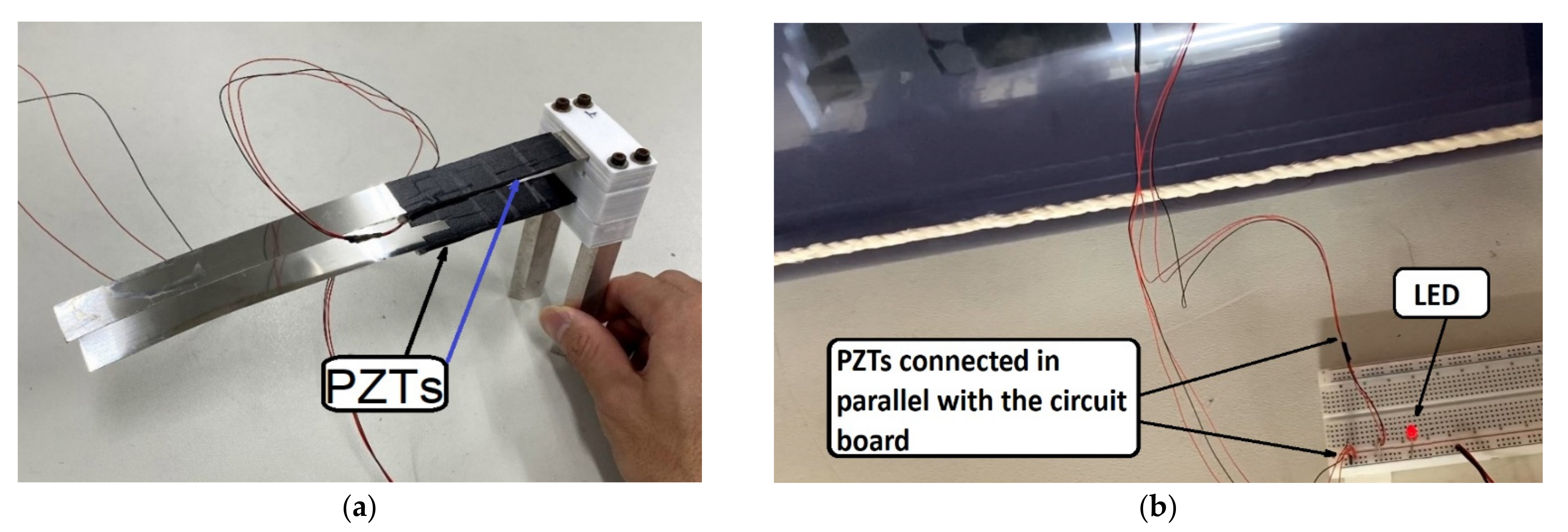

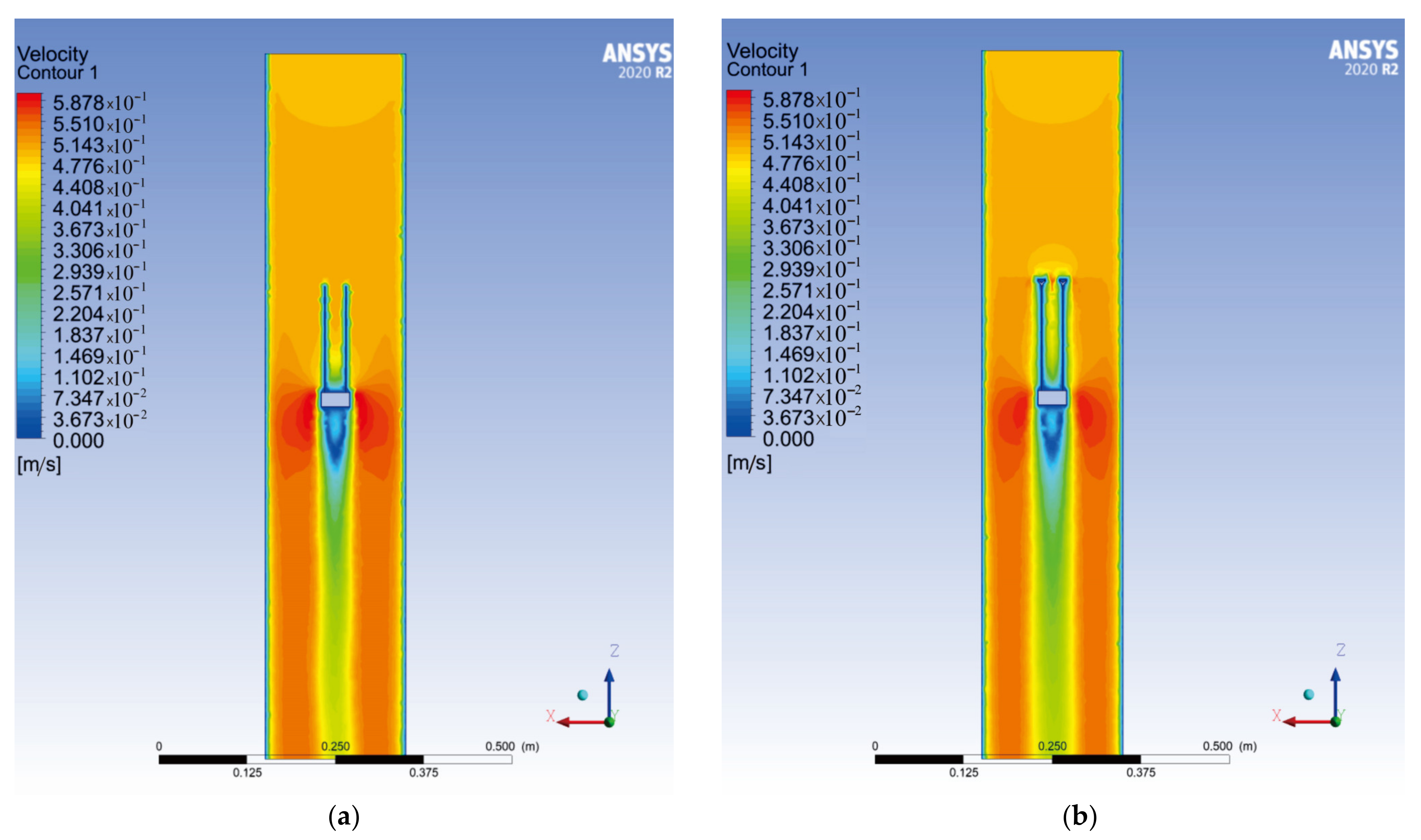
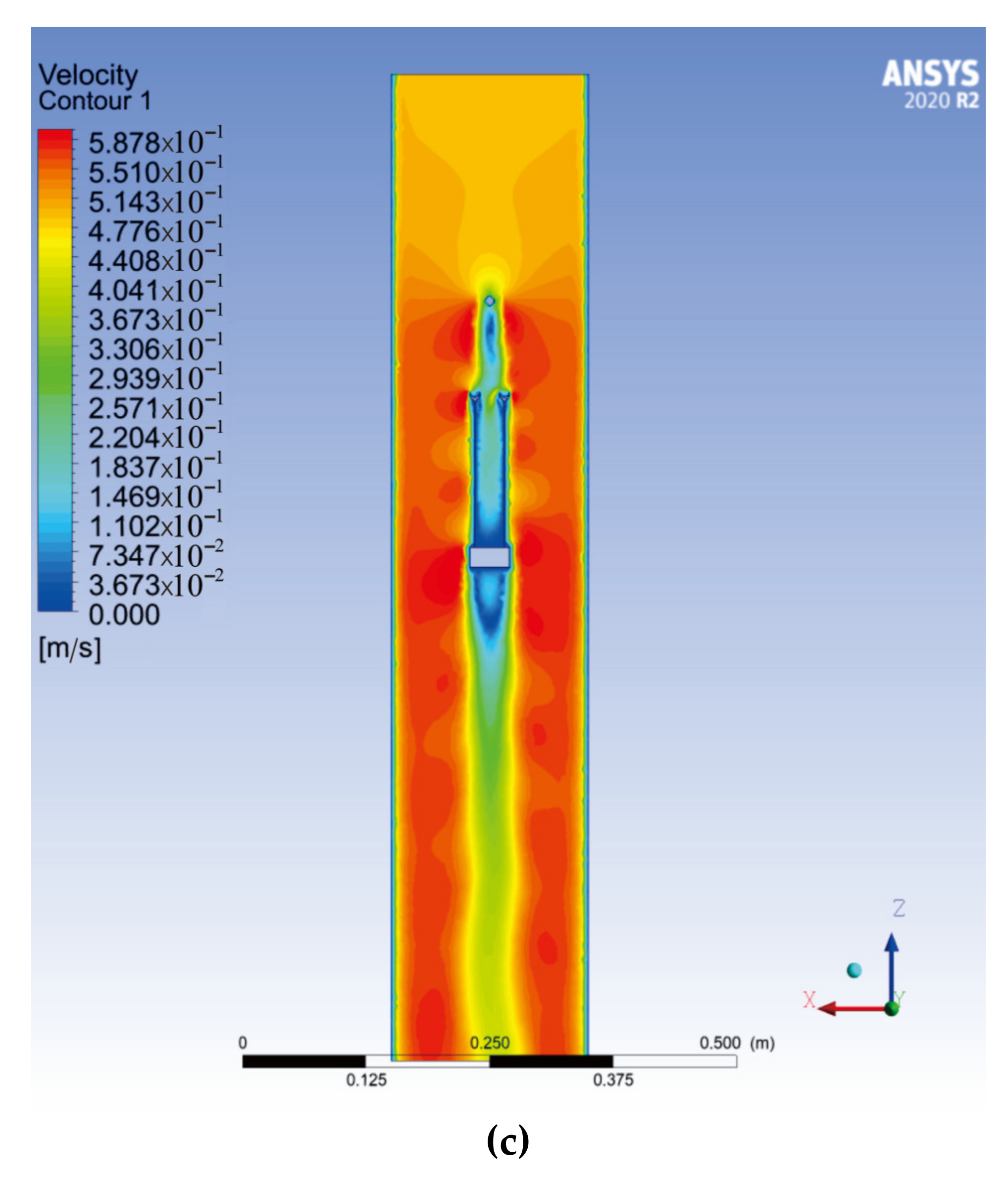
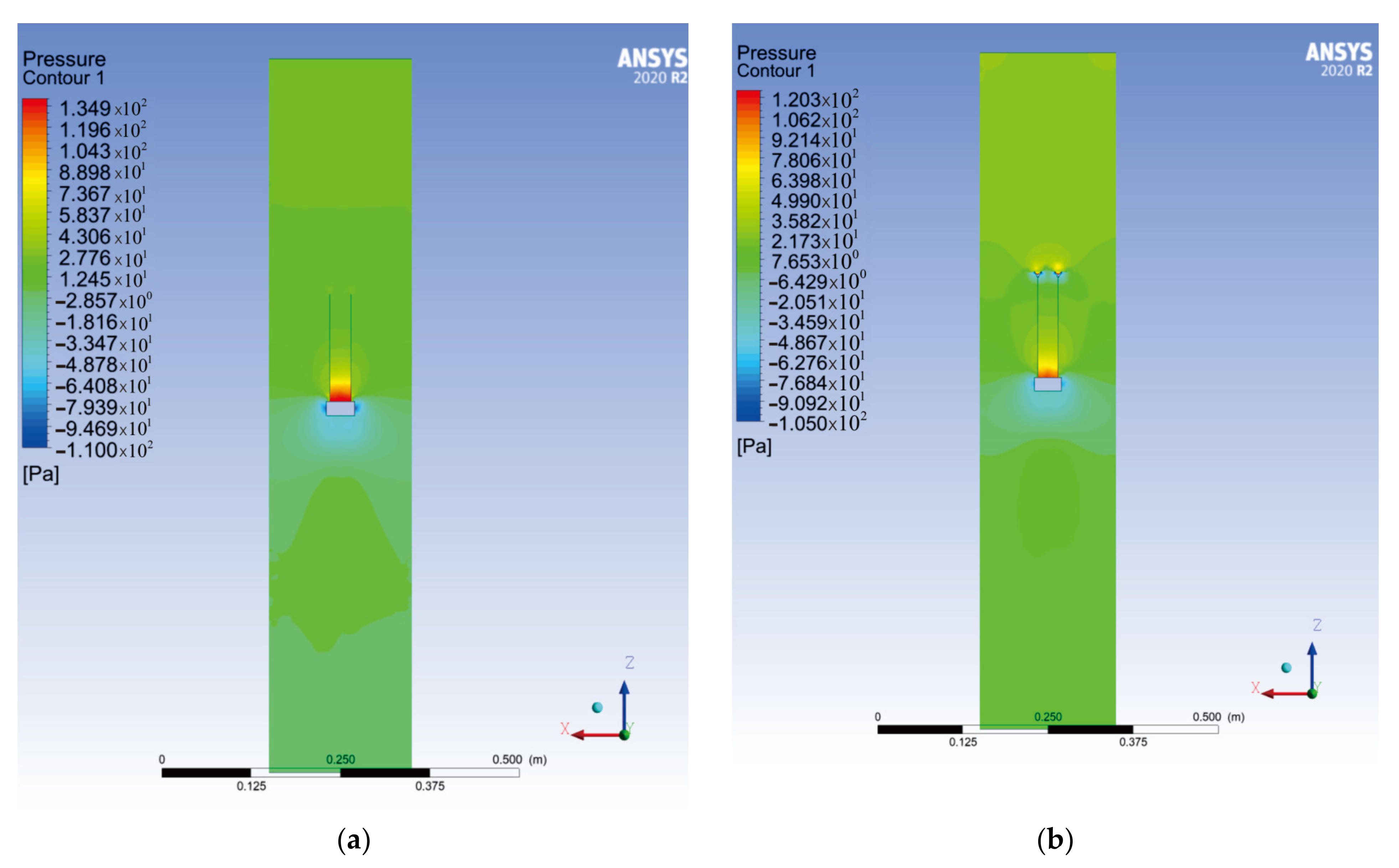

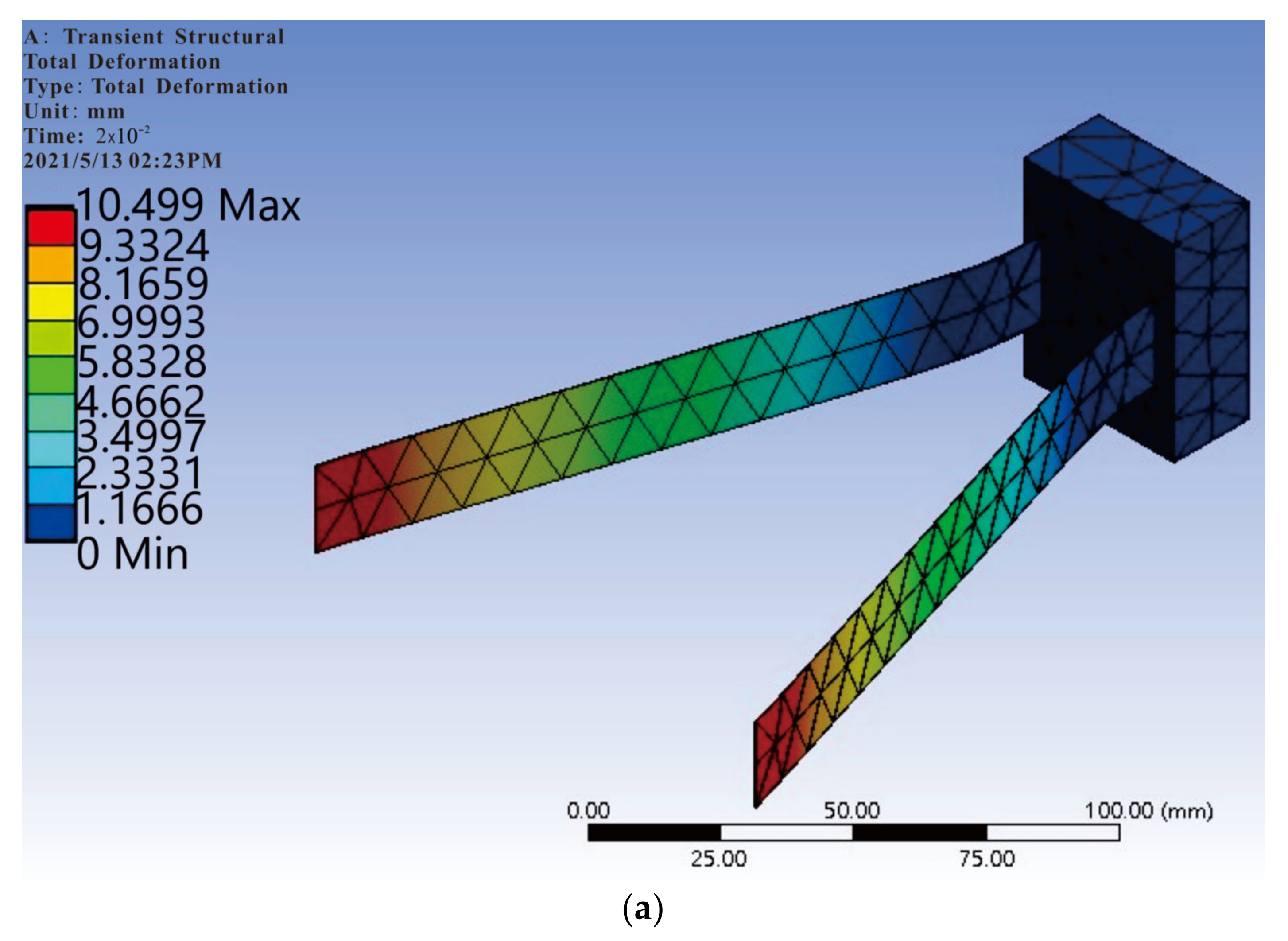
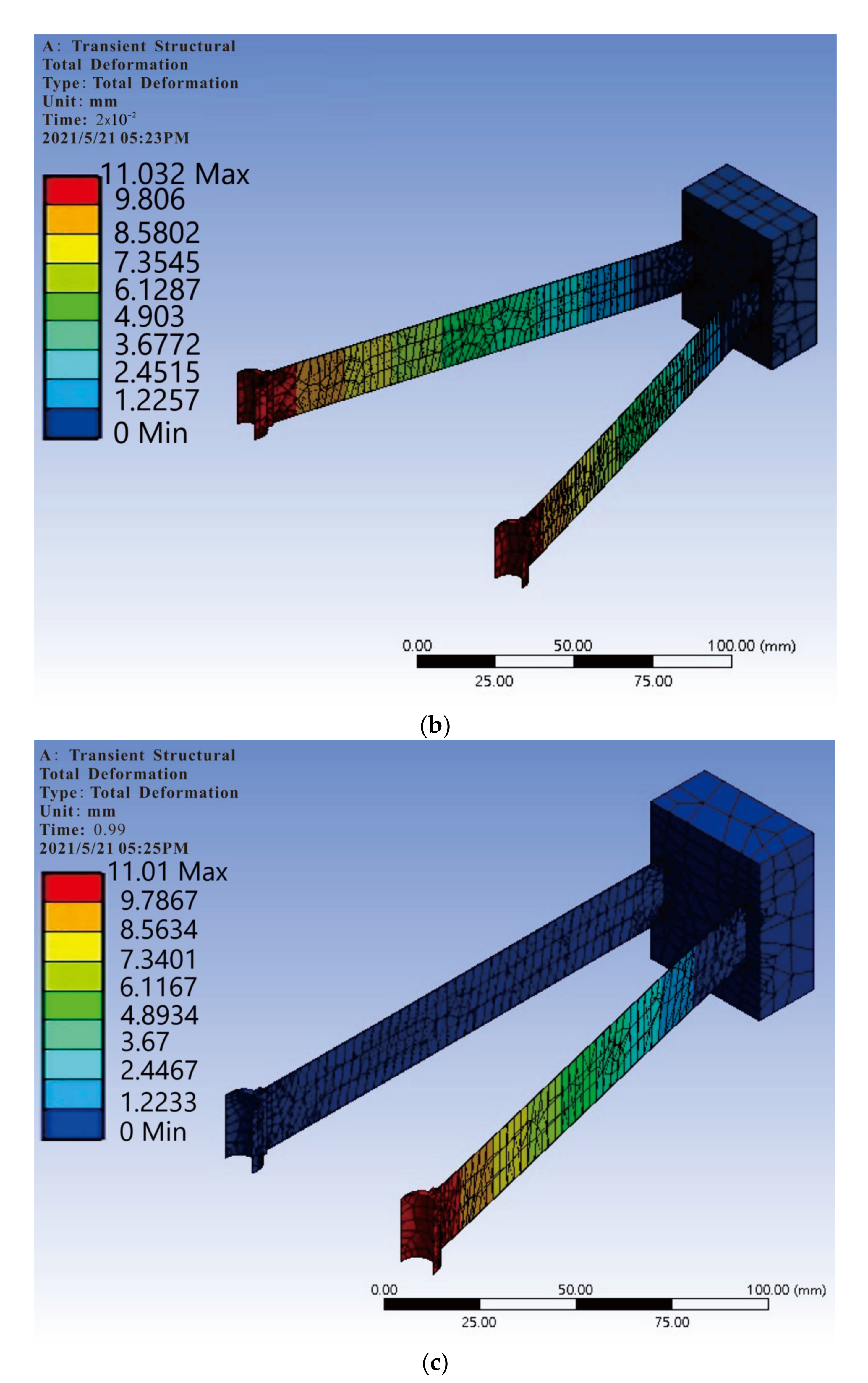
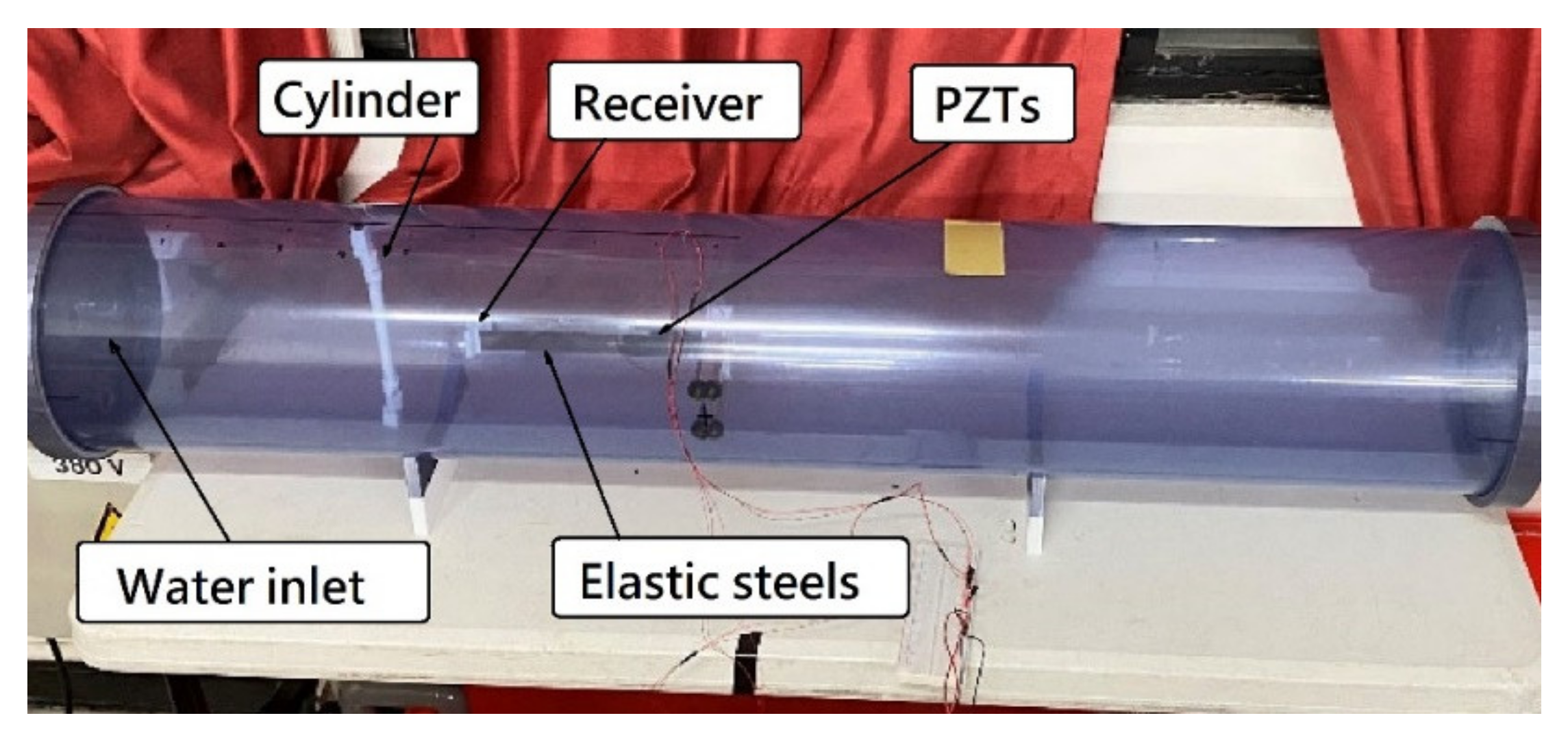
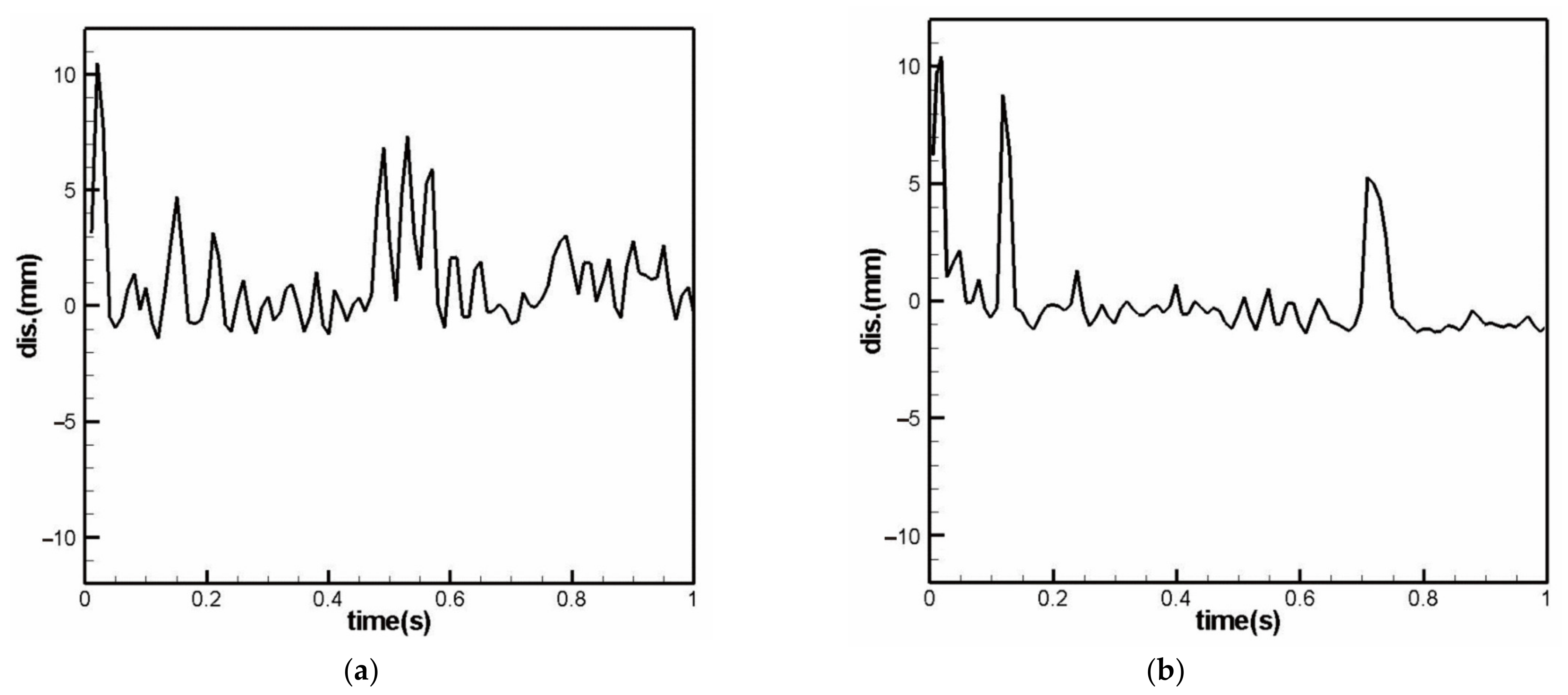
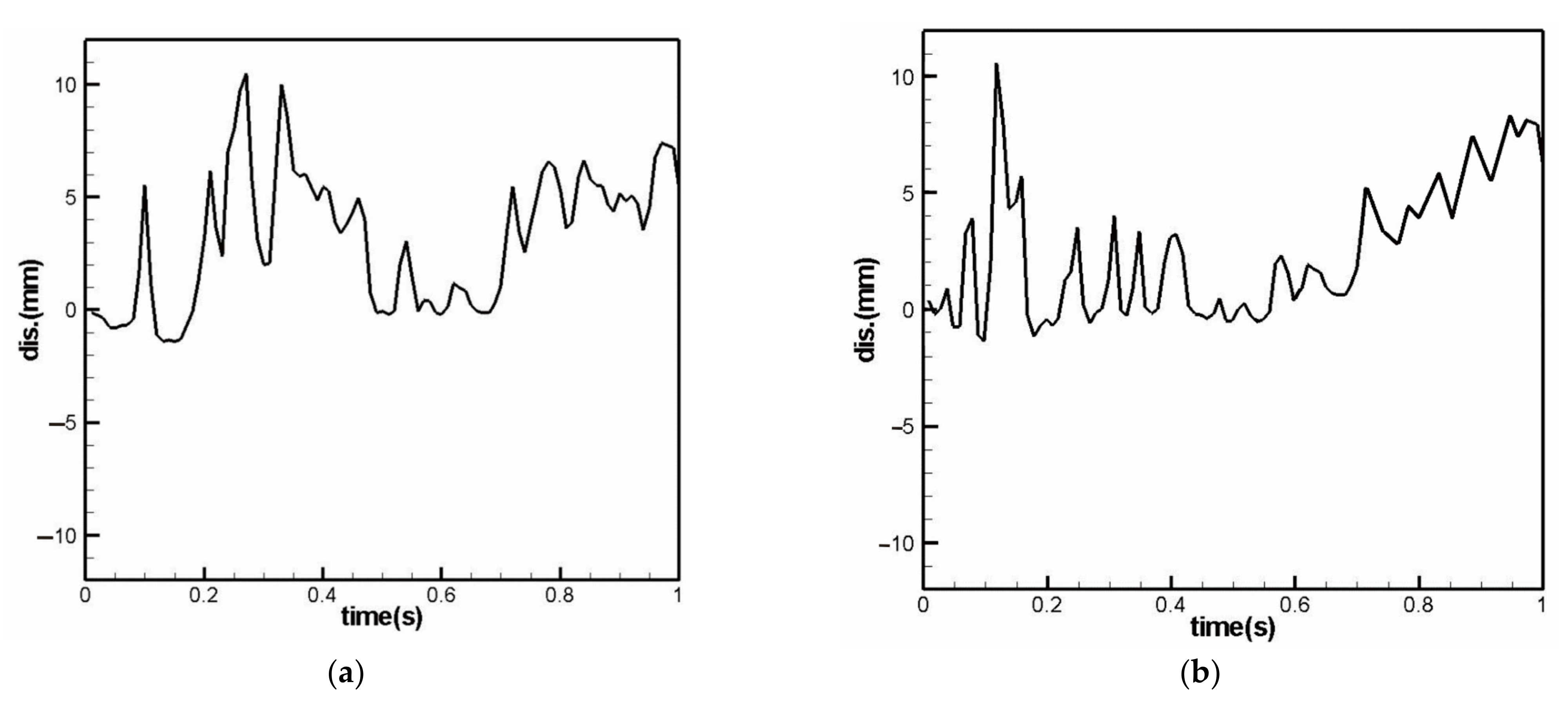

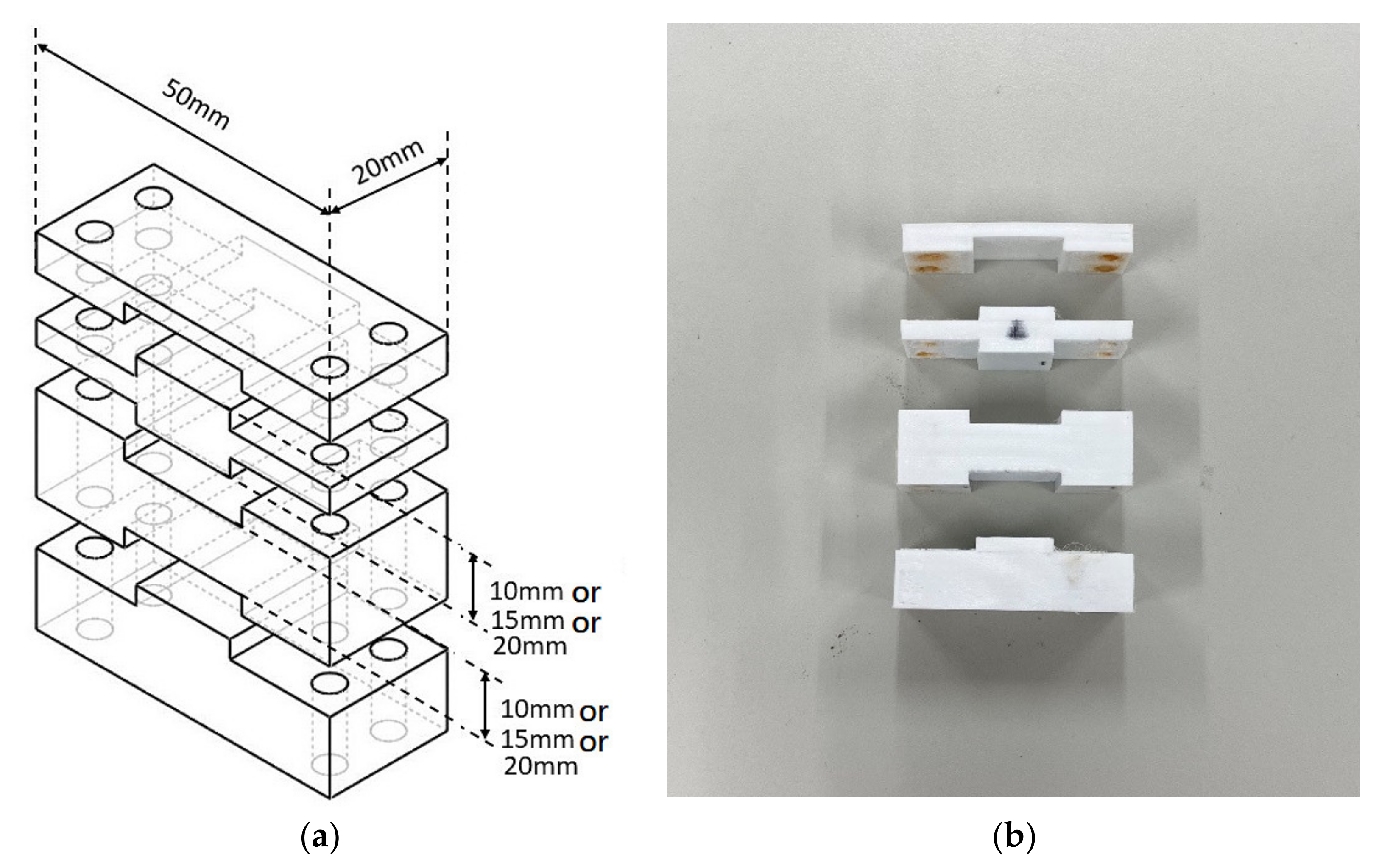

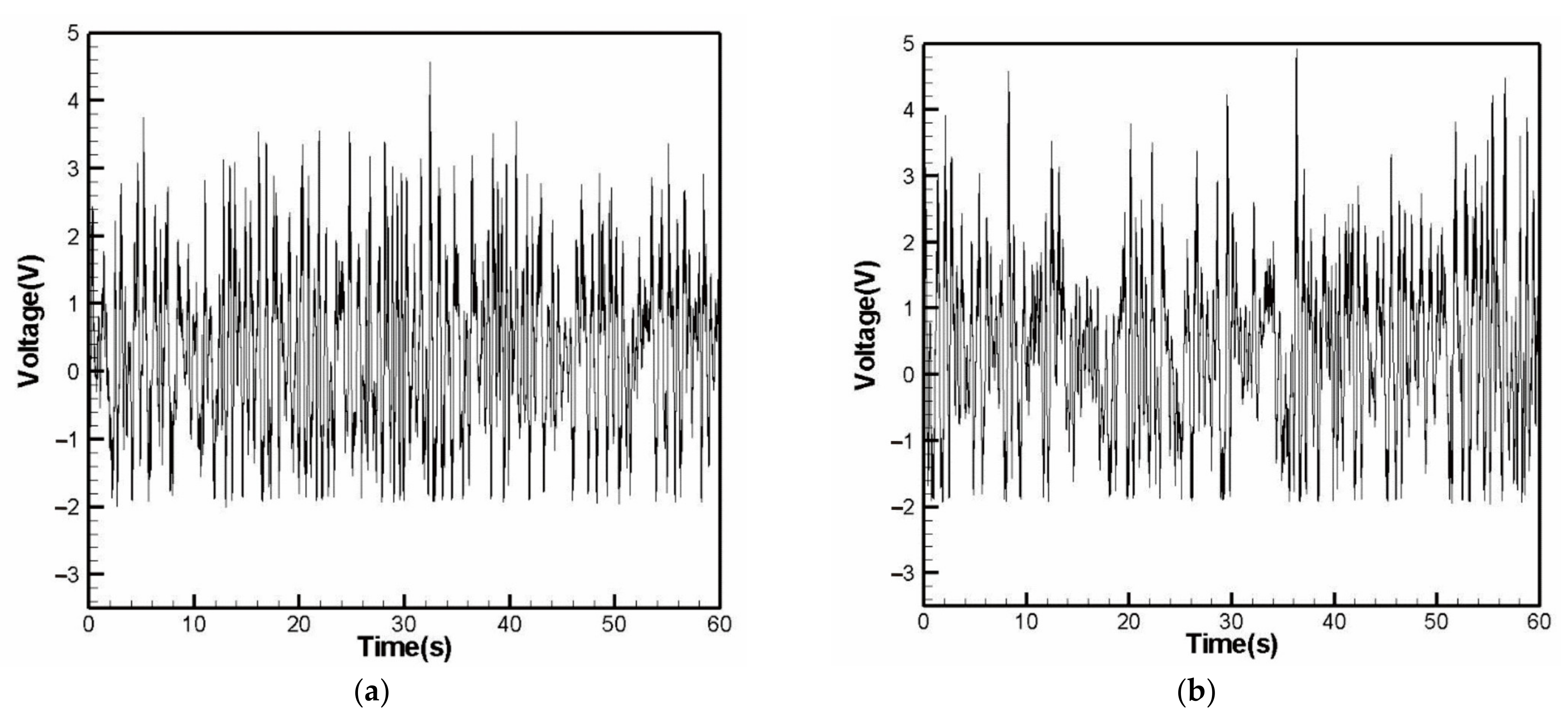
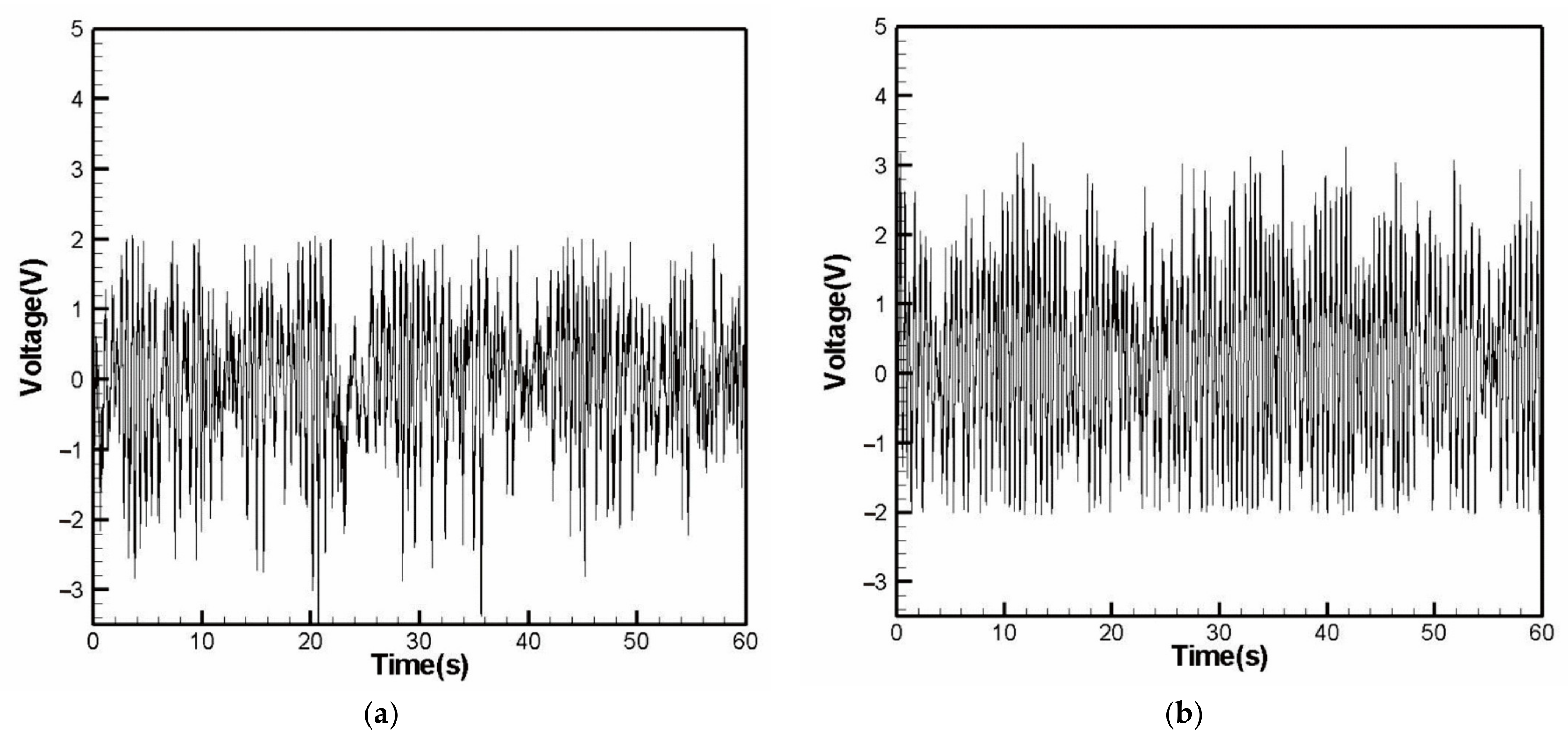
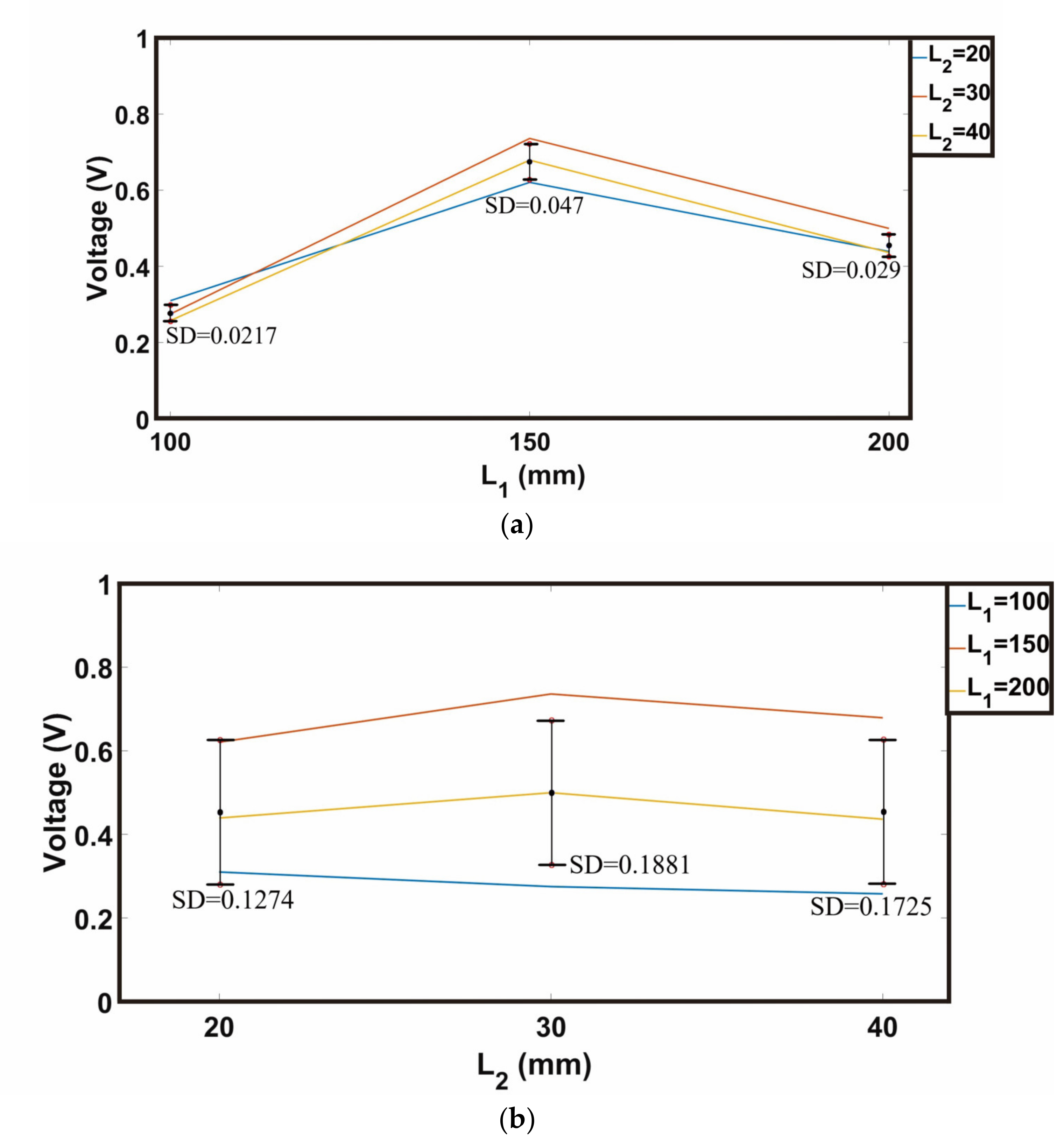



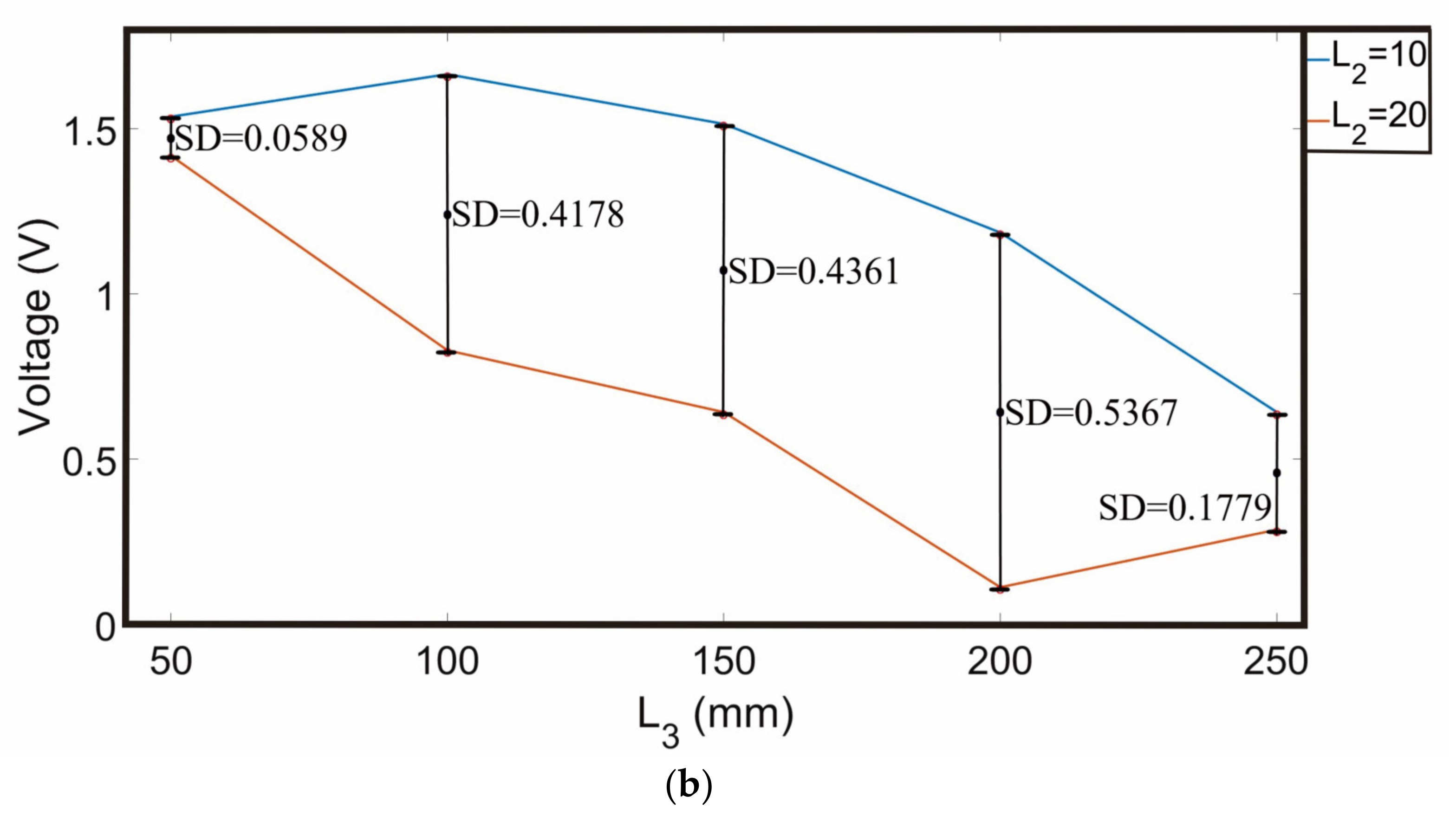
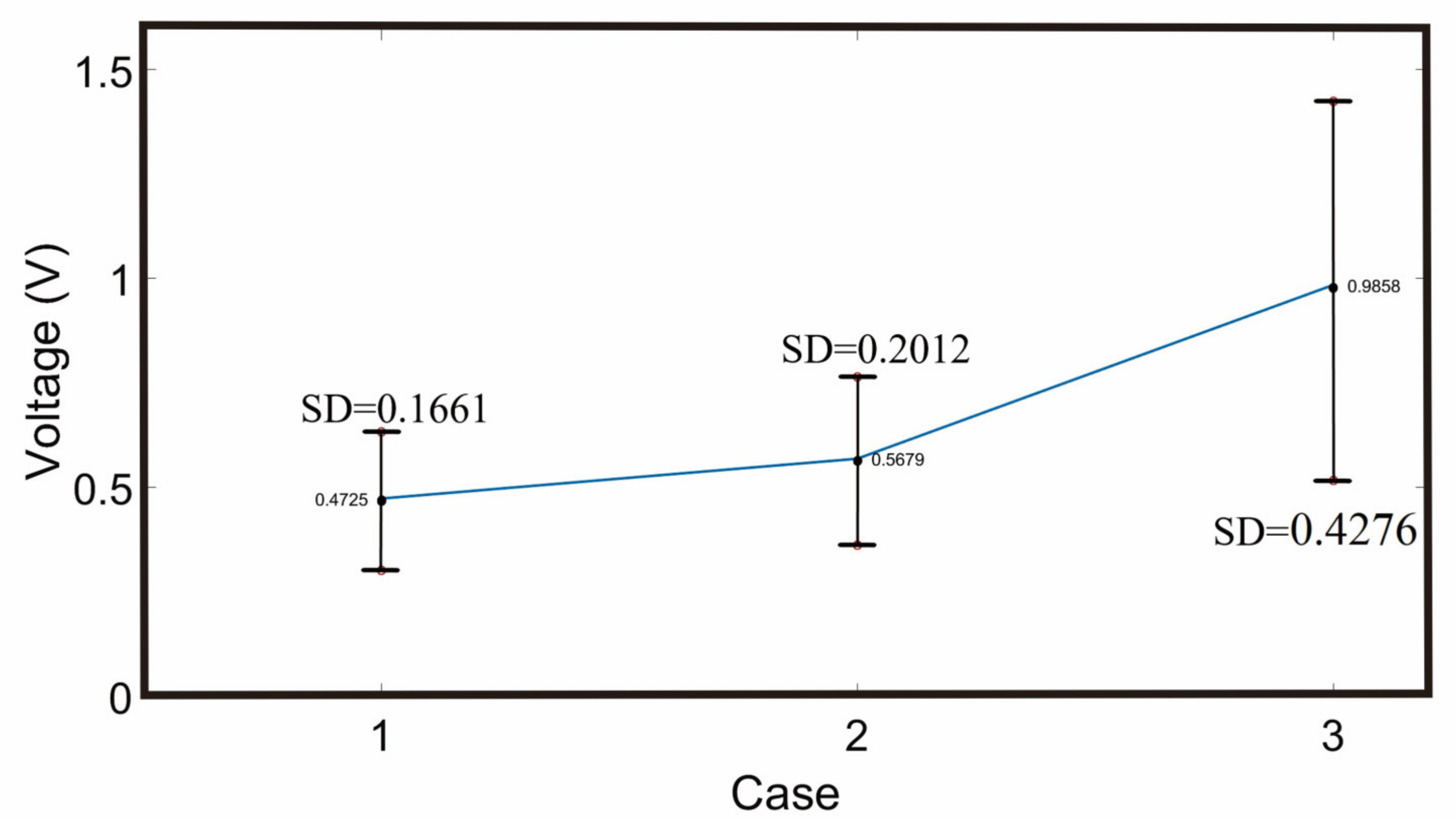
| Sample | L1 (mm) | L2 (mm) | Average (V) |
|---|---|---|---|
| 1 | 100 | 20 | 0.3100 |
| 2 | 100 | 30 | 0.2751 |
| 3 | 100 | 40 | 0.2578 |
| 4 | 150 | 20 | 0.6205 |
| 5 | 150 | 30 | 0.7357 |
| 6 | 150 | 40 | 0.6788 |
| 7 | 200 | 20 | 0.4391 |
| 8 | 200 | 30 | 0.4996 |
| 9 | 200 | 40 | 0.4363 |
| AVE | 0.4725 |
| Sample | L1 (mm) | L2 (mm) | D1 | Average (V) |
|---|---|---|---|---|
| 1 | 100 | 20 | 5 | 0.2332 |
| 2 | 100 | 30 | 5 | 0.3273 |
| 3 | 100 | 40 | 5 | 0.3235 |
| 4 | 150 | 20 | 5 | 0.6841 |
| 5 | 150 | 30 | 5 | 0.7691 |
| 6 | 150 | 40 | 5 | 0.6147 |
| 7 | 200 | 20 | 5 | 0.4924 |
| 8 | 200 | 30 | 5 | 0.5410 |
| 9 | 200 | 40 | 5 | 0.4408 |
| 10 | 100 | 20 | 10 | 0.3295 |
| 11 | 100 | 30 | 10 | 0.3802 |
| 12 | 100 | 40 | 10 | 0.3493 |
| 13 | 150 | 20 | 10 | 0.9959 |
| 14 | 150 | 30 | 10 | 1.0368 |
| 15 | 150 | 40 | 10 | 0.7220 |
| 16 | 200 | 20 | 10 | 0.6107 |
| 17 | 200 | 30 | 10 | 0.6073 |
| 18 | 200 | 40 | 10 | 0.5550 |
| 19 | 100 | 30 | 15 | 0.4490 |
| 20 | 100 | 40 | 15 | 0.4452 |
| 21 | 150 | 30 | 15 | 0.7691 |
| 22 | 150 | 40 | 15 | 0.6629 |
| 23 | 200 | 30 | 15 | 0.7051 |
| 24 | 200 | 40 | 15 | 0.6147 |
| AVE | 0.5691 |
| Sample | L3 (mm) | D2 (mm) | Average (V) |
|---|---|---|---|
| 1 | 50 | 10 | 1.5369 |
| 2 | 50 | 20 | 1.4190 |
| 3 | 100 | 10 | 1.6657 |
| 4 | 100 | 20 | 0.8300 |
| 5 | 150 | 10 | 1.5151 |
| 6 | 150 | 20 | 0.6428 |
| 7 | 200 | 10 | 1.1863 |
| 8 | 200 | 20 | 0.1128 |
| 9 | 250 | 10 | 0.6428 |
| 10 | 250 | 20 | 0.2871 |
| AVE | 0.9858 |
Disclaimer/Publisher’s Note: The statements, opinions and data contained in all publications are solely those of the individual author(s) and contributor(s) and not of MDPI and/or the editor(s). MDPI and/or the editor(s) disclaim responsibility for any injury to people or property resulting from any ideas, methods, instructions or products referred to in the content. |
© 2022 by the authors. Licensee MDPI, Basel, Switzerland. This article is an open access article distributed under the terms and conditions of the Creative Commons Attribution (CC BY) license (https://creativecommons.org/licenses/by/4.0/).
Share and Cite
Wang, Y.-R.; Chen, P.-T.; Hsieh, Y.-T. Analysis of Double Inverted Flag Energy Harvesting System in Pipe Flow. Sustainability 2023, 15, 704. https://doi.org/10.3390/su15010704
Wang Y-R, Chen P-T, Hsieh Y-T. Analysis of Double Inverted Flag Energy Harvesting System in Pipe Flow. Sustainability. 2023; 15(1):704. https://doi.org/10.3390/su15010704
Chicago/Turabian StyleWang, Yi-Ren, Pin-Tung Chen, and Yen-Te Hsieh. 2023. "Analysis of Double Inverted Flag Energy Harvesting System in Pipe Flow" Sustainability 15, no. 1: 704. https://doi.org/10.3390/su15010704







